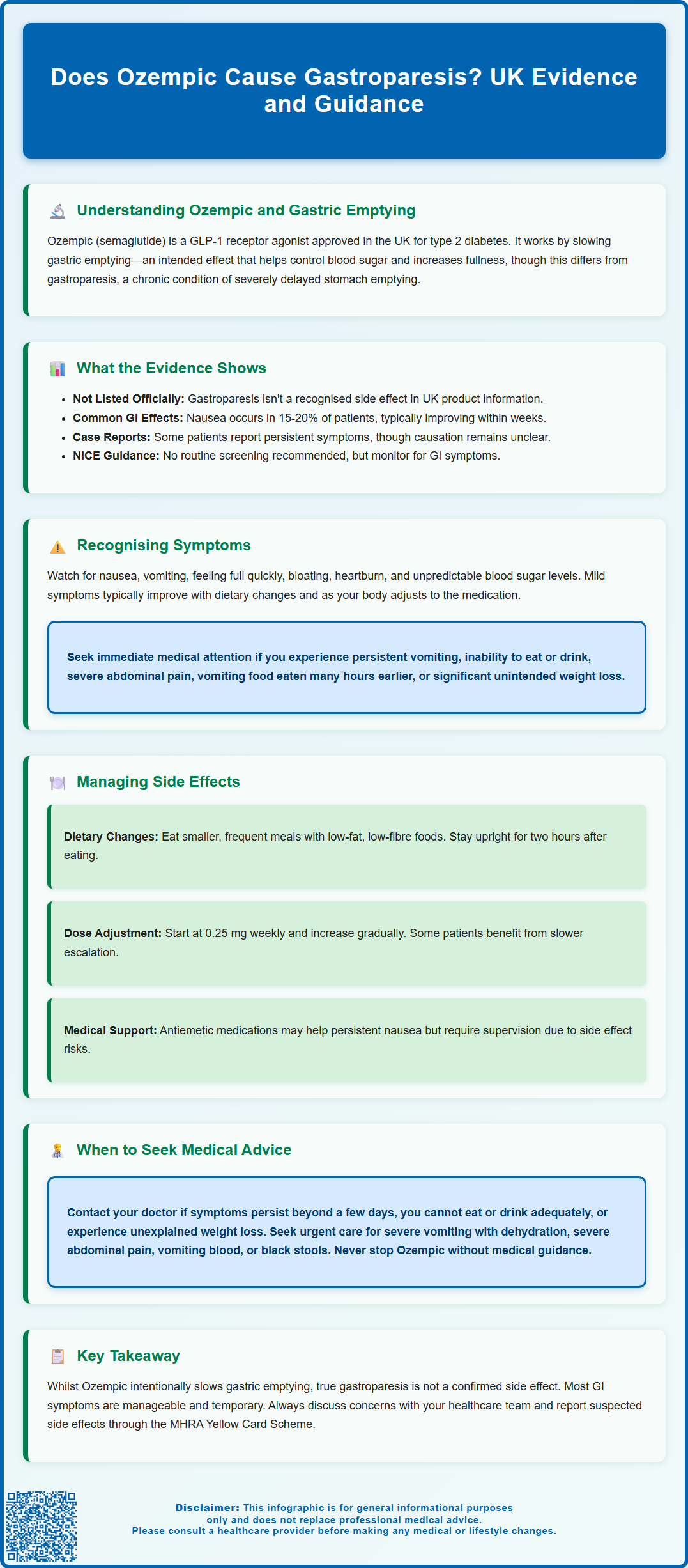Mounjaro®
Dual-agonist support that helps curb appetite, hunger, and cravings to drive substantial, sustained weight loss.
- ~22.5% average body weight loss
- Significant weight reduction
- Improves blood sugar levels
- Clinically proven weight loss

Does Ozempic cause gastroparesis? This question concerns many patients prescribed semaglutide for type 2 diabetes. Ozempic is a GLP-1 receptor agonist that intentionally slows gastric emptying as part of its mechanism to control blood glucose. Whilst delayed gastric emptying is an expected pharmacological effect that can cause nausea and early satiety, gastroparesis is a distinct chronic condition characterised by significantly impaired stomach emptying without mechanical obstruction. Understanding the difference between these two phenomena, recognising concerning symptoms, and knowing when to seek medical advice are essential for patients taking this medication. This article examines the evidence linking Ozempic to gastroparesis and provides practical guidance for UK patients.
Summary: Ozempic intentionally slows gastric emptying as part of its mechanism, but gastroparesis is not currently listed as a recognised adverse reaction in UK product information, though the relationship remains under investigation.
Ozempic (semaglutide) is a glucagon-like peptide-1 (GLP-1) receptor agonist licensed in the UK for the treatment of type 2 diabetes mellitus. The Medicines and Healthcare products Regulatory Agency (MHRA) approved this medication based on its ability to improve glycaemic control in appropriate patients. Semaglutide works by mimicking the action of naturally occurring GLP-1, a hormone released from the intestine in response to food intake.
The mechanism of action of Ozempic involves several physiological effects that contribute to its glucose-lowering properties. Firstly , it stimulates insulin secretion from pancreatic beta cells in a glucose-dependent manner, meaning insulin release occurs primarily when blood glucose levels are elevated. Secondly , it suppresses glucagon secretion, thereby reducing hepatic glucose production. Thirdly , and particularly relevant to this discussion, semaglutide slows gastric emptying—the rate at which food moves from the stomach into the small intestine.
This delayed gastric emptying is an intended pharmacological effect of GLP-1 receptor agonists that can manifest as gastrointestinal adverse reactions such as nausea and vomiting. By slowing the passage of food from the stomach, Ozempic helps to moderate post-prandial (after-meal) glucose spikes and promotes satiety. The degree of gastric slowing varies between individuals and may diminish somewhat with continued treatment as the body adapts to the medication.
It is important to note that the Summary of Product Characteristics (SmPC) for Ozempic advises caution in patients with pre-existing gastrointestinal disease, including severe gastroparesis. Understanding the distinction between the expected slowing of gastric emptying—which occurs with Ozempic—and gastroparesis, a chronic medical condition characterised by significantly delayed gastric emptying in the absence of mechanical obstruction, is essential when evaluating concerns about whether Ozempic causes gastroparesis.
The question of whether Ozempic causes gastroparesis has generated considerable discussion in both medical literature and patient communities. According to the UK product information, gastroparesis is not currently listed as a recognised adverse drug reaction to semaglutide, although gastrointestinal adverse effects—including nausea, vomiting, diarrhoea, and constipation—are common. The relationship between GLP-1 receptor agonists and persistent gastroparesis remains under investigation.
Clinical trial data and post-marketing surveillance have documented that gastrointestinal side effects are among the most common adverse reactions to GLP-1 receptor agonists. In pivotal trials, nausea occurred in approximately 15–20% of patients taking semaglutide, with frequency increasing at higher doses. These symptoms generally reflect the medication's effect on gastric motility rather than pathological gastroparesis. Most patients experience improvement in gastrointestinal symptoms over time as tolerance develops, usually within the first few weeks to months of treatment.
However, case reports and observational studies have described instances where patients taking GLP-1 receptor agonists experienced severe, persistent symptoms consistent with gastroparesis. Some of these cases involved symptoms that continued even after discontinuation of the medication, raising questions about potential longer-term effects on gastric function. It remains unclear whether these represent drug-induced gastroparesis or exacerbation of pre-existing, undiagnosed gastric motility disorders.
The National Institute for Health and Care Excellence (NICE) acknowledges the gastrointestinal effects of GLP-1 receptor agonists in its guidance on type 2 diabetes management (NG28) but does not currently recommend routine screening for gastroparesis before or during treatment. Healthcare professionals are advised to monitor patients for gastrointestinal symptoms and adjust treatment accordingly.
It is important to note that severe abdominal pain could also indicate other serious conditions mentioned in the Ozempic SmPC, such as pancreatitis or gallbladder disease, which require prompt medical assessment. Further research is needed to clarify the relationship between long-term GLP-1 receptor agonist use and persistent gastric motility disorders.

Patients taking Ozempic should be aware of symptoms that may indicate significant delayed gastric emptying, whether as an expected medication effect or potentially more concerning gastroparesis. Common symptoms include:
Nausea and vomiting, particularly after meals or in the morning
Early satiety—feeling full after eating only small amounts of food
Abdominal bloating and distension, often worsening throughout the day
Upper abdominal discomfort or pain
Heartburn or acid reflux due to prolonged retention of stomach contents
Loss of appetite and unintentional weight loss beyond expected therapeutic effects
Fluctuating blood glucose levels, as unpredictable gastric emptying affects carbohydrate absorption
For most patients on Ozempic, mild to moderate gastrointestinal symptoms are transient and manageable, typically occurring during the initial weeks of treatment or following dose increases. These symptoms often improve with dietary modifications and usually resolve as the body adjusts to the medication. However, severe or persistent symptoms warrant medical evaluation.
Warning signs that require prompt assessment include:
Persistent vomiting that prevents adequate fluid or medication intake
Inability to maintain nutrition or hydration
Severe abdominal pain (which could indicate pancreatitis, gallbladder disease, or other serious conditions)
Vomiting of undigested food consumed many hours previously
Significant unintended weight loss
Worsening glycaemic control despite medication adherence
It is worth noting that symptoms alone cannot definitively distinguish between expected medication effects and true gastroparesis. Formal diagnosis of gastroparesis requires objective testing, typically gastric emptying scintigraphy (a nuclear medicine study that measures the rate of gastric emptying). Wireless motility capsule studies may be available in selected specialist NHS centres. These investigations are usually reserved for patients with severe, persistent symptoms that significantly impact quality of life or nutritional status, and to exclude other causes such as mechanical obstruction.
Effective management of gastrointestinal symptoms whilst taking Ozempic can significantly improve treatment tolerance and adherence. Dietary modifications represent the first-line approach for managing delayed gastric emptying effects:
Eat smaller, more frequent meals rather than three large meals daily—this reduces the volume of food in the stomach at any one time
Choose easily digestible foods that are lower in fat and fibre, as these empty from the stomach more readily
Avoid lying down immediately after eating; remain upright for at least two hours post-meal to facilitate gastric emptying
Stay well hydrated with small, frequent sips of fluid throughout the day
Limit carbonated beverages and alcohol, which can exacerbate bloating and nausea
Chew food thoroughly to aid mechanical digestion
Medication timing and dosing strategies can also help minimise symptoms. The standard approach involves gradual dose escalation, starting at 0.25 mg weekly for four weeks, then increasing to 0.5 mg weekly. Further increases to 1 mg or 2 mg weekly should only occur if tolerated and if additional glycaemic control is needed, following the UK SmPC recommendations. Some patients benefit from a slower titration schedule, remaining at lower doses for extended periods.
For patients experiencing persistent nausea, antiemetic medications may provide symptomatic relief, though these should be used under medical supervision:
Metoclopramide—a prokinetic agent that enhances gastric motility, but MHRA restricts use to short-term only (maximum 5 days) due to neurological side effect risks
Domperidone—another prokinetic with significant restrictions in the UK due to cardiac risks (QT prolongation); requires specialist oversight, careful patient selection, and monitoring
Ondansetron—may be considered for nausea relief in selected cases, though it can cause constipation
Healthcare professionals should review concurrent medications that may further slow gastric emptying, such as opioid analgesics, anticholinergic drugs, or certain antidepressants. Where possible, alternatives should be considered.
It is important to maintain adequate hydration, as persistent vomiting or diarrhoea can lead to dehydration and potentially acute kidney injury, as noted in the Ozempic SmPC. Regular monitoring of glycaemic control, weight, and nutritional status helps ensure that gastrointestinal effects are not compromising overall diabetes management or patient wellbeing.
Patients taking Ozempic should maintain open communication with their healthcare team about any gastrointestinal symptoms. Routine follow-up is typically scheduled at three to six months after initiating treatment, but earlier contact is warranted if concerning symptoms develop.
Contact your GP or diabetes specialist nurse if you experience:
Persistent nausea or vomiting lasting more than a few days, particularly if it prevents you from taking medications or maintaining hydration
Inability to eat or drink adequately due to early satiety or abdominal discomfort
Rapid or unexplained weight loss exceeding expected therapeutic effects
Abdominal pain or distension
Vomiting of food consumed several hours previously
Worsening blood glucose control despite medication adherence
Seek urgent medical attention (contact NHS 111 or attend A&E) if you develop:
Severe, persistent vomiting with inability to keep down fluids
Signs of dehydration (dark urine, dizziness, confusion, reduced urine output)
Severe abdominal pain, especially if radiating to the back and accompanied by vomiting (which could indicate pancreatitis)
Vomiting blood or material that looks like coffee grounds
Black, tarry stools
Your healthcare provider may adjust your treatment plan by reducing the Ozempic dose, temporarily discontinuing the medication, or switching to an alternative diabetes therapy. If pancreatitis is suspected, Ozempic should be stopped immediately and not restarted if pancreatitis is confirmed, as advised in the SmPC. In cases of severe, persistent symptoms, referral to a gastroenterologist for specialist assessment may be appropriate. Investigations might include gastric emptying studies, upper gastrointestinal endoscopy, or other tests to exclude alternative diagnoses.
It is important to never stop Ozempic abruptly without medical guidance, as this may affect your diabetes control. If you have concerns about gastrointestinal side effects, discuss them with your healthcare team, who can help determine whether symptoms represent expected medication effects requiring management strategies or whether they indicate a need for treatment modification.
Patients are encouraged to report any suspected adverse reactions to Ozempic via the MHRA Yellow Card Scheme (yellowcard.mhra.gov.uk or via the Yellow Card app). This helps regulatory authorities monitor medication safety.
Ozempic intentionally slows gastric emptying as part of its therapeutic mechanism to control blood glucose and promote satiety. Gastroparesis is a distinct chronic medical condition characterised by significantly delayed gastric emptying in the absence of mechanical obstruction, requiring formal diagnostic testing such as gastric emptying scintigraphy.
Gastrointestinal side effects are among the most common adverse reactions to Ozempic. In clinical trials, nausea occurred in approximately 15–20% of patients, with symptoms typically improving over the first few weeks to months as tolerance develops.
Contact your GP if you experience persistent nausea or vomiting lasting more than a few days, inability to eat or drink adequately, or unexplained weight loss. Seek urgent medical attention for severe persistent vomiting, signs of dehydration, severe abdominal pain (especially if radiating to the back), or vomiting blood.
The health-related content published on this site is based on credible scientific sources and is periodically reviewed to ensure accuracy and relevance. Although we aim to reflect the most current medical knowledge, the material is meant for general education and awareness only.
The information on this site is not a substitute for professional medical advice. For any health concerns, please speak with a qualified medical professional. By using this information, you acknowledge responsibility for any decisions made and understand we are not liable for any consequences that may result.
Lorem ipsum dolor sit amet, consectetur adipiscing elit, sed do eiusmod tempor incididunt ut labore et dolore magna aliqua. Ut enim ad minim veniam, quis nostrud exercitation ullamco laboris nisi ut aliquip ex ea commodo consequat. Duis aute irure dolor in reprehenderit in voluptate velit esse cillum dolore eu fugiat nulla pariatur.
Block quote
Ordered list
Unordered list
Bold text
Emphasis
Superscript
Subscript